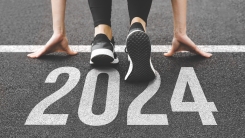These Apps Can Help You Track Any New Year’s Resolution

What kind of New Year’s resolution you make depends on your unique goals—which means you need a way to track your progress that is just as unique. If your goal is to quit social media and your friend’s is to run a faster mile, you won’t measure success the same way, right? There are different apps out there that will help you actually reach your goals this year.
This story is going to recommend some apps that can help you track specific resolutions. Here’s a rundown of the best general progress tracking apps.
What are the most common New Year’s resolutions?
Per Statista, the top New Year’s resolutions among people who have made one or several this year are as follows:
-
To save more money (59%)
-
To exercise more (50%)
-
To spend more time with family and friends (40%)
-
To lose weight (35%)
-
To spend less on living expenses (26%)
-
To spend less time on social media (19%)
-
To reduce job stress (19%)
The best app for saving money
There are a bunch of great apps out there that help you budget, but if you’re ready to get serious this year and save money in a big way, try Qapital. This one is great for a New Year’s resolution because it makes you do a little work, unlike some of the AI-powered budgeting apps that use algorithms to set aside money for you. With Qapital, you set your own rules, which means you still have to flex your own self-control muscles and actively strive toward your resolution. For instance, you can set up a rule that says when you buy a coffee, the app also moves a certain amount into savings. You can also program it to round up change on purchases and move it into your savings account. You can set goals within the app and it will create visual representations of how much you’ve saved toward them, which is great for people who need to see their progress. It’s free for a month, but after that, you’ll pay $3, $6, or $12 per month, depending on what features you want. A basic plan lets you create unlimited savings goals and transfer money between them, plus partner with another user to save together and track joint spending. More advanced versions get you the option to have a Qapital debit card or track your weekly cash spending.
The best app to track exercise frequency
If you want to work out more, it will help you to see your progress with each trip to the gym (or at-home session, whatever). For that, try Strong, an app that lets you input the exercises you do and creates graphs showing you your gradual improvement in weight, sets, body fat percentage, and more. It includes instructions on how to do a variety of exercises, which is nice if you aren’t really a fitness person (yet) and feeling nervous about trying new moves in front of other people keeps you away from the gym. The free version will save unlimited workouts, but you can only add three custom routines. For everything else, it’s $4.99 per month or $29.99 per year.
The best app for prioritizing family and friend time
If you want to spend more time with your loved ones, try Cozi, a simple organizer that gives you a clear visual representation of your whole family’s schedule. Not only can you see when everyone is free, but you can see how much time you devote (or don’t devote) to the people with whom you share the app—which can motivate you to schedule more time together. It’s also free, which is a plus. Use the money you saved to pay for a nice night out with the people you set a resolution to spend more time with.
The best app for losing weight
As someone who’s tried all the apps in this particular category, I’m going to recommend the one I’ve used most faithfully since 2012: MyFitnessPal. This damn thing has been around a long time, obviously, but in all those years, it hasn’t really changed that much. It’s simple and not at all intimidating: You set a calorie goal, enter in what you’ve eaten in a day, plus how much you’ve exercised and how much water you’ve consumed, and let MFP do the work. Its database of foods is massive, so you’ll almost always find exactly what you ate or a close approximation, plus it integrates with other activity-tracking apps and pulls your exercise-based calorie expenditure in. It tracks your weight on a graph, making it perfect for long-term resolution monitoring, too. The free version does all this, but if you want to pay $9.99 per month or $49.99 per year, it will calculate your macros, let you enter foods in by scanning their barcode, export your data, and much more.
The best bill-tracking app
Spending less on living expenses gives you more to spend on the fun stuff, which is a worthy resolution. To do it, try Rocket Money, which helps you budget, but also offers services like bill negotiation and income analysis, so you can see where you’re spending your money every month—and get rid of recurring fees you don’t actually need to be paying. Some of it is free, but if you want to create unlimited budgets, get credit reports, and access the all-important cancellation concierge (which not only identifies your recurring payments, but cancels them for you and even tries to get you fee refunds), you’ll have to pay. The app offers a sliding payment scale, so you’ll pay between $4 and $12 per month, depending on whether you want to pay monthly or annually.
The best app to spend less time on social media
It might seem counterintuitive to download another app when you’re trying to stay off the apps in the first place, but One Sec really might be the answer. All it does is cause a 10-second delay between when you tap a specific app, like Instagram, and when the app actually opens. It encourages you to take a deep breath, then tells you how many times you’ve attempted to open that app in the last 24 hours, letting you see just how often you’ve tried—and determine if you want to proceed. There are other apps out there that straight-up lock you out of your socials, but that removes the accountability from your resolution and cuts you off in a way that will be jarring and hard to stick with. Something low-stakes that doesn’t penalize you for being human and daring to open Facebook is much nicer. It’s free if you’re trying to reduce your use of one particular app, but to tackle them all, you’ll need to upgrade to a pro version for $19.99 per year or $2.99 per month.
The best app for reducing stress at work
There are lots of mindfulness and deep breathing apps out there, but those aren’t great for seeing any progress, which is what resolutions are all about. Moodfit, on the other hand, gives you not only tools for managing your mood, but insights into your various mood-based patterns. You can track your mood, gratitude, mindfulness, and breathing while seeing your progress in numbers and on a chart. You can even track nutrition, sleep, and medications to see how those play a role in your mood, too. Seeing it all laid out will help you home in on what besides work is affecting you, but also see exactly when and how during work you’re getting upset, then make the effort to adjust when necessary to reduce stress. A basic version is free, but it’s $8.99 to access all the features, including personalized reports and unlimited goals.



